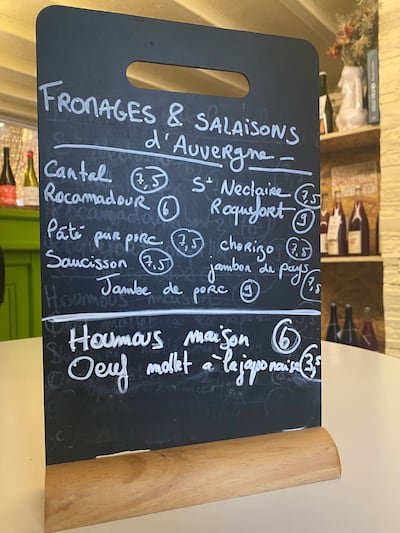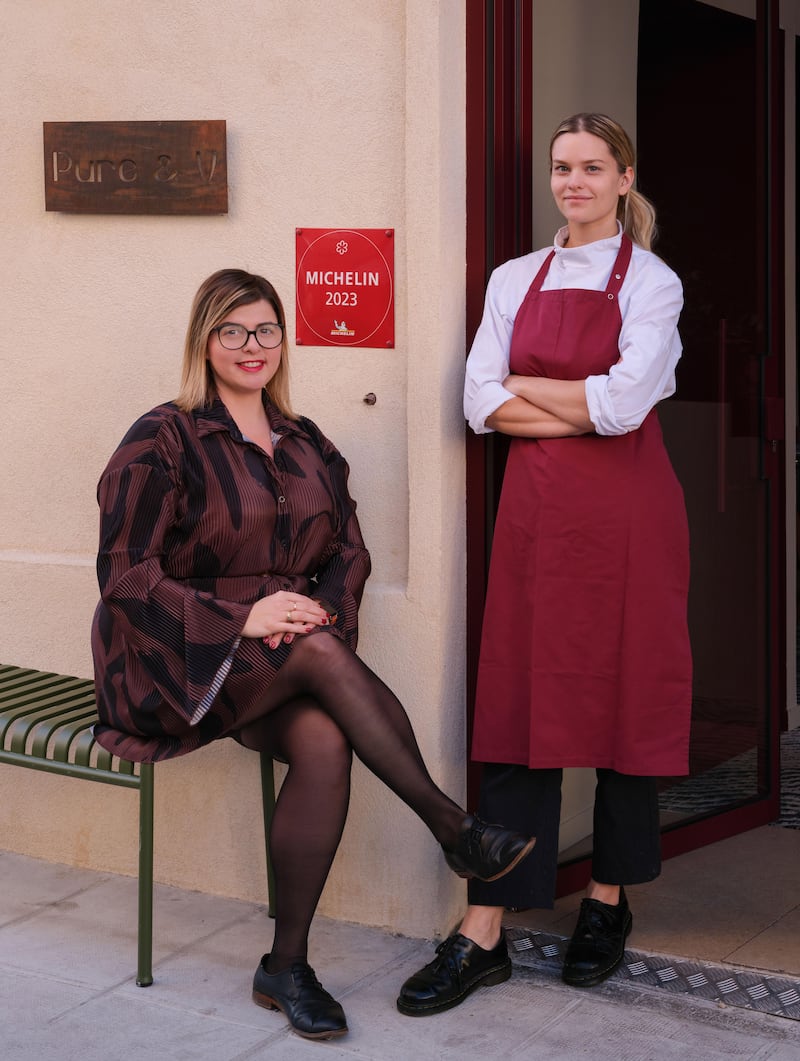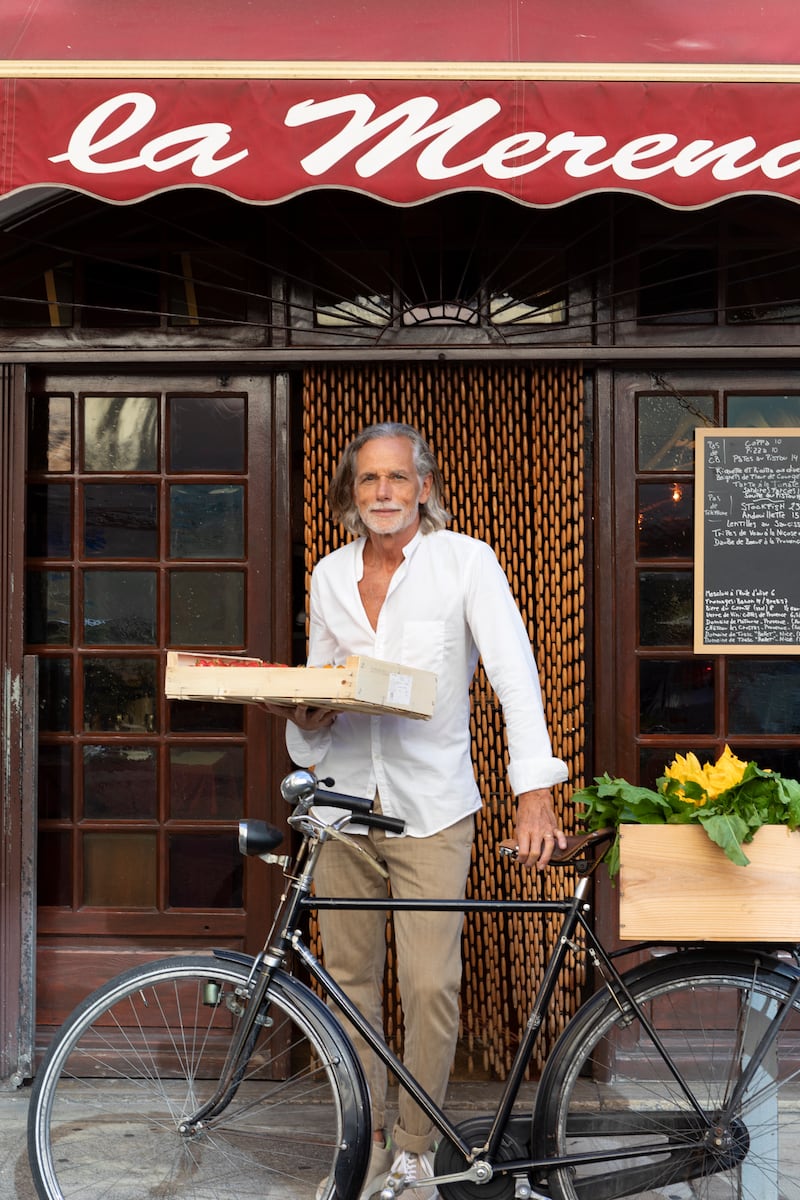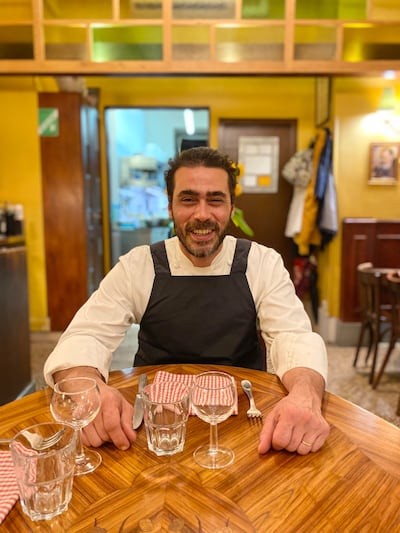It’s a beautiful sunny Sunday as we stroll through the old port, Nice’s coolest quarter, or Port Lympia to give it its official name. The traditionally working-class neighbourhood – known for its antique shops and brightly coloured “pointus” (traditional wooden boats) – has flourished since the new tram line connecting it to Nice airport opened in 2019.
We are lucky to land a table at Le Bistrot du Port on Quai Lunel. Sunday lunch is a big thing for the locals, who know that booking is essential, and all the outside tables are gone. But it matters little as sitting inside with a view out to the water is pretty wonderful. A small table with a bowl of clementines separates us from our neighbours and we end up having a lovely conversation with them, a retired doctor and his wife, originally from Bordeaux, now living in Nice.
Two dishes that I always associate with the south of France are on the menu. Soupe de poisson comes with a side bowl of croutons and a clove of garlic on a fork so you can add a whack more if you please. The saffron-coloured rouille is glossy and wobbly; ready to be spread on the croutons, topped with grated cheese and floated in the scalding hot soup. And then there’s wild sea bass in salt, which always feels a bit special. Brought to the table encrusted, the salt shell is cracked, the fish removed and served as glistening white fillets with olive oil and a rocket salad. Le Bistrot du Port is not the cheapest place to dine, the sea bass is €50 per person, but you will dine very well and you most certainly won’t need dinner.

Go one street in from the harbour to Boulevard Stalingrad and you’ll find wood-fired pizzas in La Tartane, considered by many to be the best in Nice. Across the street is Glouphile, a wine bar with plates of home-made charcuterie and cheese. It’s got a classic list with plenty of interesting bottles and knowledgeable staff to guide you. Epiro is the place to head for home-made pasta; and Romans Alessandra Viscardi and Marco Mattana have an Italian wine list that focuses on small-scale producers.
READ MORE
The wine scene is big in Nice, with recently opened natural wine bars serving some of the best food in the city, driven by an influx of sommeliers and chefs from Paris, Rome and Copenhagen.
At Rouge on Rue de Foresta, Gautier Creissard, who had previously worked with Yves Camdeborde in Paris (the chef behind “bistronomy”), and his wife Alexandra offer a tantalising amount of natural wines by the glass. Tasty bites on pretty mismatched plates include new season asparagus, deep fried courgette flowers, and baby leeks in a smoked eel foam.
A couple of blocks in from the harbour is Fanfan & Loulou, a cave and bar à vins naturels on Rue Lascaris, with Serge Gainsbourg and Talking Heads playing on vinyl and a 1970s retro vibe. Fanfan is from the Auvergne, where she sources beautiful cheeses, and the delicious vegetable dishes are Loulou’s speciality. There are plenty of interesting wines by the glass and if you fancy a bottle, corkage is €5.

Nearby on Rue Cassini, a large trailer inside La Pêche à la Vigne is the novel display set-up for a formidable selection of cheese. A seat at one of the small marble tables in this Italian grocers and wine shop, owned by Sicilians Leo and Simona Mazzarone, is the perfect spot for a light lunch. Petite soupe and croque-monsieur à la maison is about €15, and can be washed down with a cool glass of biodynamic wine.
La Pêche wine bar next door is open in the evening. It’s incredibly relaxed, staff will bring bottles to the table and have a bit of a discussion to help you choose. Prices are reasonable, just €5 above retail price. The menu is chalked up on a board and fried chicken with mayo, beef pie with two cheeses, ravioli with kimchi, and shakshuka had us well sated with a light red wine from the Jura region. It’s a great place to try some new wines, especially if you generally find that it intimidating.
Drop into La Part des Anges on Rue Gubernatis for a serious selection of low-intervention wine, and if you’re there around lunchtime, have a tasty plate of charcuterie.
One of the buzziest wine bars in Nice is Babel Babel on the Promenade des Anglais, where Copenhagen native Pernille Stubbs (formerly of Michelin-starred Septime in Paris) manages the very impressive wine list. I was in contact with her before I headed over to Nice, so many of my recommendations are from her. Babel Babel is a buzzy Mediterranean-inspired restaurant and bar over two floors, with a small but wonderful terrace where you can perch on a stool and watch the sunset as you sip something refreshing. Small plates are reasonably priced and there’s plenty on the menu, including terrine with broad beans, boudin noir with sprouted broccoli, calamari a la plancha, grilled mushrooms and charred bavette with sesame hollandaise.
Pernille is also the somm behind sister bar à vin Barrique in a renovated theatre on Rue Barillerie in Vieux Nice. It has a broader European slant to the wine selection, with corkage at €5, which seems to be the going rate.
Another star sommelier who has decamped to the Riviera is Vanessa Massé, who worked in Belgium, Copenhagen and Singapore before opening Pure & V in 2018. With an extensive natural wine list and Nordic-influenced dishes, it landed a Michelin star in 2020. The kitchen is now headed by Pinja Paakkonen, the former pastry chef from Alchemist restaurant in Copenhagen. If the newer wave of Michelin dining is your thing, you’ll find plenty to love here, starting with a croustade of smoked crème fraîche and broad beans, and beef tartare with sorrel in a kohlrabi taco, moving on to a chicken ballotine with sweetbreads and morel mushrooms. It may sound French but is quite different in execution. The cooking is restrained, led by the pure flavour of vegetables rather than the richness of butter. You will, of course, be paying Michelin-star prices, and it is considerably more formal than a typical Niçois restaurant.

For that experience, head to La Merenda on Rue Raoul Bosio, a compact, old-school restaurant, where former Michelin-starred chef Dominique Le Stanc can be seen cooking in the kitchen. It’s cash only, with starters about €12 and main courses about €20. It’s Niçois food, and to some, that is the joy of tripe and andouillettes, but if offal is not your thing, the pissaladière (the Provençal anchovy and olive-topped onion tart), which comes on the crumbliest of pastries, is very good. So too is the pesto. It’s a room mostly filled with tourists, and there’s quite a bit of high volume English, Dutch and Scandinavian gastro-babble. The tête de veau with gribiche comes with a boiled potato and it’s well worth going for the green salad as a side as it is quite beautiful and skilfully dressed. Dessert is simple too, a tarte au citron, requisitely sharp with citrus, and a light chocolate mousse. Walk-ins who are unaware that you can book on Instagram are turned away, and the tables turn in just over an hour.

For something quieter, head to Chez Davia on Rue Grimaldi, a family-owned restaurant led by Pierre Altobelli that stole my heart. Solidly French, the whole room turns to inspect you when you walk in. We seem to be the only foreigners, the tables are tightly packed, and there’s a sharing table in the middle with a large vase of flowers.
Artichokes are just in season, so we have them in a cold salad. Barbaguans de la Roya, the deep-fried pastries from Monte Carlo filled with cheese, spinach and onions, are served daintily, in a dish with a doily. Red mullet has been fried, and the fish aioli Provençal is an enormous dish, with salt cod, boiled egg and green beans to be dipped in the wonderful garlic mayonnaise. We had been warned, and really, this is a dish more suited to sharing between a few at the table. Dessert is spectacular, a most amazing tarte au citron, and a fascinating tarte aux pommes that is cooked as a dome.

A few blocks away is Le Canon on Rue Meyerbeer, a natural wine bar and restaurant with no wine list, where the somm chats to you about what you like and brings three bottles for you to choose from. That may not be everyone’s idea of a comfortable start to the evening, but if you go with the flow, you’ll end up trying something special. It’s more of a three-course set-up than a small-plates approach and the food is typically traditional.
[ Welcome to my place ... NiceOpens in new window ]
If you are staying for more than a week, make sure to get another great Sunday lunch booked. I would suggest Safari in the Cours Saleya. Ask for an outside table and don’t forget your Panama hat. Add in a museum or two to your list. Buy the €15 museum ticket, take the number 5 bus to the Matisse museum, which is quite beautiful, and check out the Chagall museum on the way back.
[ Nice seems minded to keep memories of mass murder out of sightOpens in new window ]
Hire an e-bike, cycle up the Castle Hill for some spectacular views, then head to Villefranche for a spot of affordable lunch by the port. I can recommend the frito misto at Lou Bantry. Or go all out as we did and hire an E-type Jaguar or other classic car for the day, drive through the national park and stop in La Turbie for lunch. We caught the end of the food market as we headed to Café de la Fontaine, the sister restaurant of Michelin-starred l’Hostellerie Jérôme. It serves an old school menu; a favourite of Michelin-starred chef Alain Ducasse.
Nice is so much more than a weekend break, and the shoulder months are the perfect time to visit, before the crowds and the sweltering weather arrive. Be sure to plan ahead and book the restaurants you want, so you can avoid the more touristy menus.













